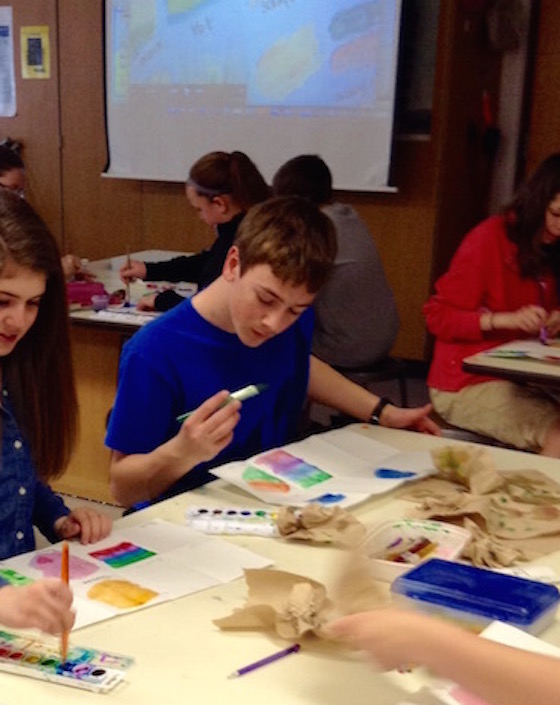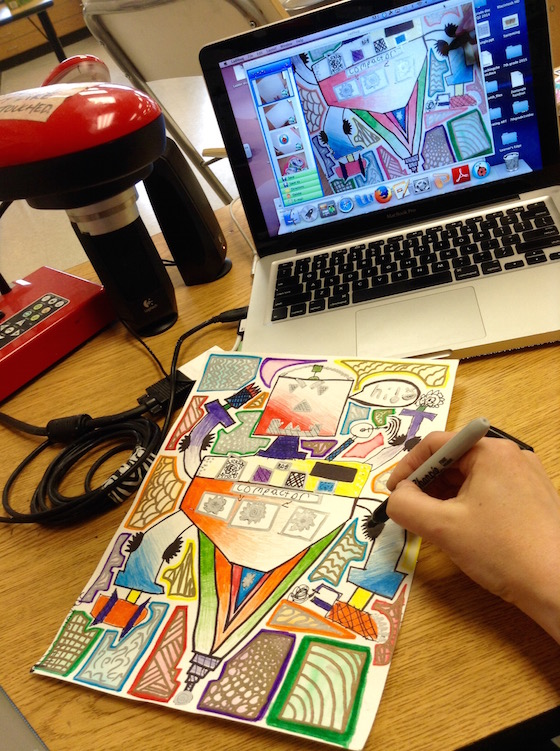A few years ago, I unexpectedly received a doc camera from some local grant funds and…my teaching life has not been the same since.
The doc cam allowed me to completely change how I run demonstrations in my room. I was used to demonstrating to my middle school students by having them gather around a table. There, I would show them the various techniques, materials and outcomes for the day. This method worked fine — until my class sizes jumped from 20 students to 30+ students. Demonstrating studio techniques around a single table with 32 eighth graders the size of grown adults (especially on P.E. days) just became too much for all of us to handle.
Naturally, the doc cam was a great fit for demonstrating to large classes without the hassle of everyone standing around a table. Projecting my demonstration onto a screen at the front of the room meant no more “so-and-so touched me!” or “I can’t see!” However, the benefits didn’t end there.
I came to appreciate how my doc cam was more than just a way to project my demos on a large scale. Here are three unexpected benefits of having a document camera in the art room.

1. You can use it as a personal lesson recorder.
I realized soon after I started using the camera that one of the major benefits was the video recording option. Since I teach the same class four times a day, I always record the demonstration that I give to my first-hour class. I then use that video demo with my other three classes throughout the day. This method leads me to reflect on and evaluate my instructional methods repeatedly as the day goes on. I’ll often stop the pre-recorded video and re-explain concepts to students if they look lost. It’s almost like having two of me in the room. The students watch my demonstration on screen, but I can provide live commentary at strategic points of the video demo. Using these recorded demos also works great for students who were absent and need to see the demonstrations from days missed.
2. It makes keeping instruction consistent a breeze.
Because all course sections are essentially watching the exact same demo, the consistency of how and what I express to each class is identical. This solved a major issue for me, as I used to struggle with being consistent when explaining assignments or teaching new concepts over and over. Now, I am confident that all students are receiving the same information. Using a doc cam in this way could be a huge benefit in an elementary art room as well, where a teacher might see sections spread out over a number of days or weeks.

3. It saves your voice and your energy.
Since teaching art all day requires never-ending endurance, I used to leave feeling absolutely exhausted. Recording my demos has helped me get to the end of the day with more energy and a level mood. It’s almost like semi-flipping my class. Although the kids are still seeing the demo during class time, the time I spend answering questions and helping during work time is much more involved because I don’t feel like I’ve exhausted all my energy during my demonstrations.

Although I do occasionally still demonstrate live at a table with all my students standing around me, I am increasingly pleased about how my document camera has changed my teaching style and helped my classroom management.
Do you use a document camera in your room? What benefits do you see?
Do you have any other tricks to save your energy throughout the day?
Magazine articles and podcasts are opinions of professional education contributors and do not necessarily represent the position of the Art of Education University (AOEU) or its academic offerings. Contributors use terms in the way they are most often talked about in the scope of their educational experiences.




